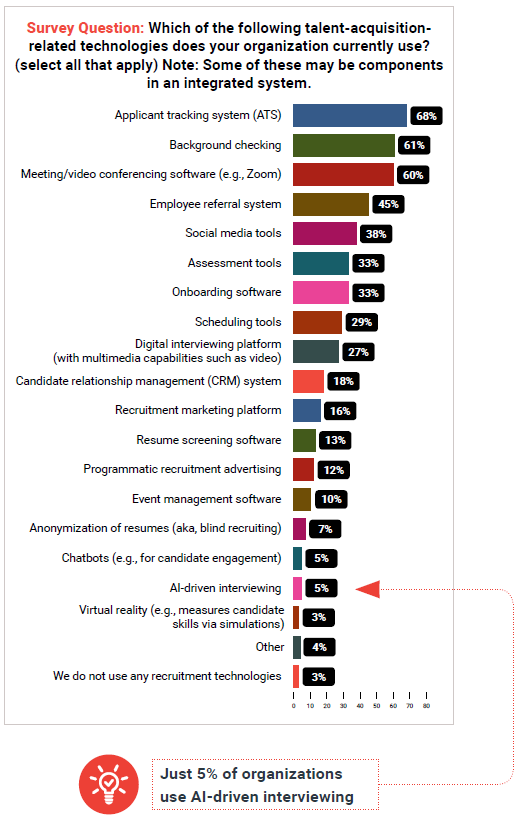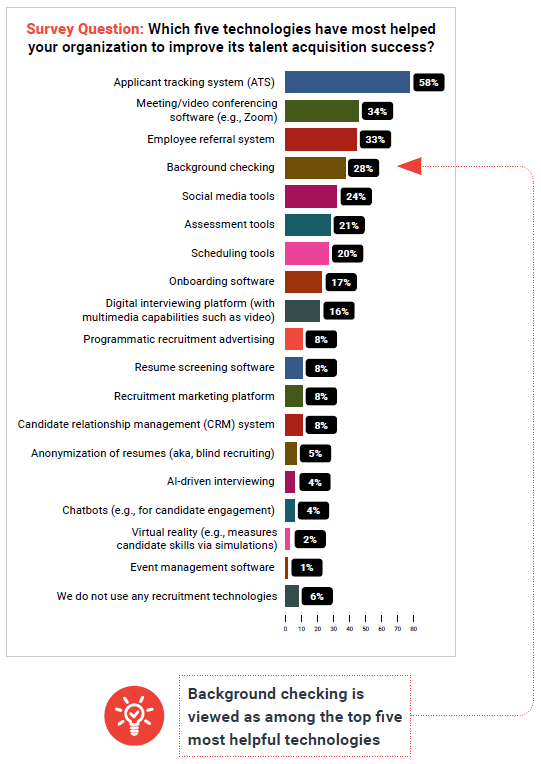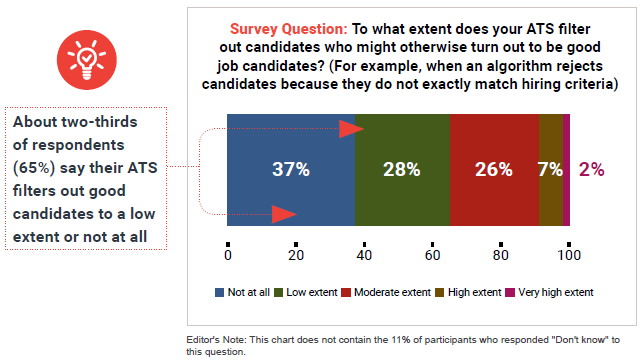Most companies use few of the talent-acquisition-related technologies that are now available
Although virtually all respondents (97%) say their organizations use some type of TA technology, only three talent-acquisition-related technologies are currently used by more than half of the respondents:
- applicant tracking systems (68%)
- background checking (61%)
- video conferencing (60%)
Just under half (45%) use an employee referral system and 38% social media tools.
While a few of the technologies covered in this question might be considered “exotic” (e.g., AI-driven interviewing, virtual reality), most of them deal with standard elements of the recruiting process. In other words, relatively few companies are taking advantage of all the technologies on offer, or their current technologies don’t have these features added yet. Organizations may be sticking with a handful of core technologies rather than spreading their budget across numerous applications. After all, these technologies would also need to be integrated with one another to be effective recruitment tools.

Impact of organization size
Larger organizations are more than twice as likely as small organizations to use an ATS (88% vs. 41%). Mid-sized organizations fall in the middle, with 65% using an ATS.
ATS are the most commonly used technology, and also the most helpful
We asked respondents to indicate the five technologies that have most helped their organization improve talent acquisition success. Only one technology was selected by more than half of respondents: applicant track systems, or ATS (58%).
The second most helpful technology is meeting/video conferencing software (34%). Naturally, with more remote hiring, more recruiting professionals turned to remote interviewing in place of in-person interviews.
However, when we compare use against helpfulness, the data tells a slightly different story. For example, when confined only to those who say they use an ATS, fully 80% say it is one of the five technologies that helps their organization see TA success.
More than a third say their ATSs sometimes filter out potentially good candidates by mistake
One fear about ATSs is that they will mistakenly filter out good candidates. This is a legitimate concern in many organizations that use an ATS. In fact, more than a third (36%) say that, to at least a moderate extent, their ATSs filter out candidates who might otherwise turn out to be good job candidates. On the other hand, only 9% say their ATS’s algorithm filters out potentially good candidates to a high or very high extent, and about two-thirds (65%) say it happens to a low extent or not at all.
We should note that we removed the 11% of respondents who say they don't know the extent to the extent to which their ATS do this. We would recommend that such organizations attempt to find out the degree to which such unintentional filtering occurs. Moreover, even though this appears to be a rare occurrence for a majority organizations, HR should consider doing spot checks of filtered out candidates and adjust the screening algorithm if errors are found.
Impact of organization size
Respondents at large organizations are more likely to feel their ATS filters are working well. More than half (51%) of respondents in large organizations say their ATS doesn’t filter out potentially good candidates at all, compared with 38% of respondents in mid-sized organizations and 29% of those in small organizations.


